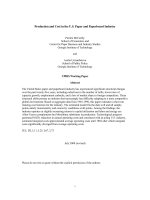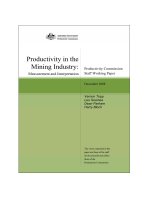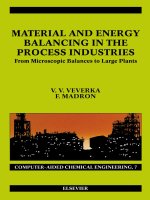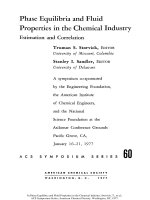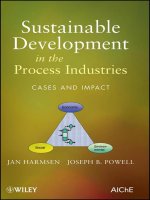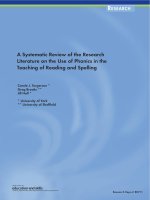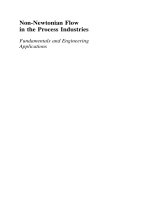chhabra & richardson (1999) non newtonian flow in the process industries fundamental and engineering applications
Bạn đang xem bản rút gọn của tài liệu. Xem và tải ngay bản đầy đủ của tài liệu tại đây (3.02 MB, 436 trang )
Non-Newtonian Flow
in the Process Industries
Fundamentals and Engineering
Applications
Non-Newtonian Flow
in the Process Industries
Fundamentals and Engineering
Applications
R.P. Chhabra
Department of Chemical Engineering
Indian Institute of Technology
Kanpur 208 016
India
and
J.F. Richardson
Department of Chemical and Biological Process Engineering
University of Wales, Swansea
Swansea SA2 8PP
Great Britain
OXFORD AUCKLAND
BOSTON JOHANNESBURG MELBOURNE NEW DELHI
Butterworth-Heinemann
Linacre House, Jordan Hill, Oxford OX2 8DP
225 Wildwood Avenue, Woburn, MA 01801-2041
A division of Reed Educational and Professional Publishing Ltd
First published 1999
© R.P. Chhabra and J.F. Richardson 1999
All rights reserved. No part of this publication
may be reproduced in any material form (including
photocopying or storing in any medium by electronic
means and whether or not transiently or incidentally
to some other use of this publication) without the
written permission of the copyright holder except
in accordance with the provisions of the Copyright,
Designs and Patents Act 1988 or under the terms of a
licence issued by the Copyright Licensing Agency Ltd,
90 Tottenham Court Road, London, England W1P 9HE.
Applications for the copyright holder’s written permission
to reproduce any part of this publication should be addressed
to the publishers
British Library Cataloguing in Publication Data
A catalogue record for this book is available from the British Library
Library of Congress Cataloguing in Publication Data
A catalogue record for this book is available from the Library of Congress
ISBN 0 7506 3770 6
Typeset by Laser Words, Madras, India
Printed in Great Britain
............................................
Preface
....................................
Acknowledgements
1 Non-Newtonian fluid behaviour ..............
1
1.1 Introduction ....................................................
1
1.2 Classification of fluid behaviour .....................
1
1.2.1 Definition of a Newtonian fluid ......................
1.2.2 Non-Newtonian fluid behaviour ....................
1.3 Time-independent fluid behaviour ...................
1.3.1 Shear-thinning or pseudoplastic fluids .........
1.3.2 Viscoplastic fluid behaviour ..........................
1.3.3 Shear-thickening or dilatant fluid
behaviour ..............................................................
1
5
6
6
11
1.4 Time-dependent fluid behaviour ....................
15
1.4.1 Thixotropy ....................................................
1.4.2 Rheopexy or negative thixotropy ..................
16
17
1.5 Visco-elastic fluid behaviour ..........................
19
1.6 Dimensional considerations for
visco-elastic fluids ................................................
28
Example 1.1 ..........................................................
31
1.7 Further Reading .............................................
34
1.8 References .....................................................
35
14
.................................................
1.9 Nomenclature
2 Rheometry for non-Newtonian fluids
.....
....................................................
2.1 Introduction
.....................................
2.2 Capillary viscometers
2.2.1 Analysis of data and treatment of results .....
Example 2.1 ..........................................................
38
40
2.3 Rotational viscometers ...................................
42
2.3.1 The concentric cylinder geometry ................
42
2.3.2 The wide-gap rotational viscometer:
determination of the flow curve for a
non-Newtonian fluid ..............................................
2.3.3 The cone-and-plate geometry ......................
2.3.4 The parallel plate geometry ..........................
2.3.5 Moisture loss prevention the vapour
hood ......................................................................
44
47
48
2.4 The controlled stress rheometer ....................
50
2.5 Yield stress measurements ............................
52
2.6 Normal stress measurements ........................
56
2.7 Oscillatory shear measurements ...................
57
2.7.1 Fourier transform mechanical
spectroscopy (FTMS) ............................................
60
2.8 High frequency techniques ............................
63
2.8.1 Resonance-based techniques ......................
2.8.2 Pulse propagation techniques ......................
64
64
2.9 The relaxation time spectrum .........................
65
2.10 Extensional flow measurements ..................
66
2.10.1 Lubricated planar stagnation die-flows .......
2.10.2 Filament-stretching techniques ..................
2.10.3 Other simple methods ..............................
67
67
68
2.11 Further reading ............................................
69
2.12 References ...................................................
69
2.13 Nomenclature ...............................................
71
49
3 Flow in pipes and in conduits of non..............................
circular cross- sections
....................................................
3.1 Introduction
3.2 Laminar flow in circular tubes ........................
74
3.2.1 Power-law fluids ...........................................
Example 3.1 ..........................................................
3.2.2 Bingham plastic and yield-pseudoplastic
fluids ......................................................................
Example 3.2 ..........................................................
3.2.3 Average kinetic energy of fluid .....................
74
78
78
81
82
3.2.4 Generalised approach for laminar flow of
time-independent fluids .........................................
Example 3.3 ..........................................................
3.2.5 Generalised Reynolds number for the
flow of time-independent fluids ..............................
83
85
86
3.3 Criteria for transition from laminar to
turbulent flow ........................................................
90
Example 3.4 ..........................................................
Example 3.5 ..........................................................
93
95
3.4 Friction factors for transitional and
turbulent conditions ..............................................
95
3.4.1 Power-law fluids ...........................................
Example 3.6 ..........................................................
3.4.2 Viscoplastic fluids .........................................
Example 3.7 ..........................................................
3.4.3 Bowens general scale-up method ...............
Example 3.8 ..........................................................
3.4.4 Effect of pipe roughness ..............................
3.4.5 Velocity profiles in turbulent flow of
power-law fluids ....................................................
96
98
101
101
104
106
111
111
3.5 Laminar flow between two infinite parallel
plates ...................................................................
118
Example 3.9 ..........................................................
120
3.6 Laminar flow in a concentric annulus .............
122
3.6.1 Power-law fluids ...........................................
Example 3.10 ........................................................
3.6.2 Bingham plastic fluids ..................................
Example 3.11 ........................................................
124
126
127
130
3.7 Laminar flow of inelastic fluids in
non-circular ducts .................................................
133
Example 3.12 ........................................................
136
3.8 Miscellaneous frictional losses .......................
140
3.8.1 Sudden enlargement ....................................
3.8.2 Entrance effects for flow in tubes .................
3.8.3 Minor losses in fittings ..................................
3.8.4 Flow measurement .......................................
Example 3.13 ........................................................
140
142
145
146
147
3.9 Selection of pumps ........................................
149
3.9.1 Positive displacement pumps .......................
3.9.2 Centrifugal pumps ........................................
3.9.3 Screw pumps ...............................................
149
153
155
3.10 Further reading ............................................
157
3.11 References ...................................................
157
3.12 Nomenclature ...............................................
159
4 Flow of multi-phase mixtures ... pipes
in
....................................................
4.1 Introduction
4.2 Two-phase gas non-Newtonian liquid flow ...
163
4.2.1 Introduction ..................................................
4.2.2 Flow patterns ................................................
4.2.3 Prediction of flow patterns ............................
4.2.4 Holdup ..........................................................
4.2.5 Frictional pressure drop ...............................
4.2.6 Practical applications and optimum gas
flowrate for maximum power saving ......................
Example 4.1 ..........................................................
163
164
166
169
177
193
194
4.3 Two-phase liquid solid flow (hydraulic
transport) ..............................................................
197
Example 4.2 ..........................................................
201
4.4 Further reading ..............................................
202
4.5 References .....................................................
202
4.6 Nomenclature .................................................
204
.................................
5 Particulate systems
....................................................
5.1 Introduction
5.2 Drag force on a sphere ..................................
207
5.2.1 Drag on a sphere in a power-law fluid ..........
Example 5.1 ..........................................................
5.2.2 Drag on a sphere in viscoplastic fluids .........
Example 5.2 ..........................................................
5.2.3 Drag in visco-elastic fluids ............................
5.2.4 Terminal falling velocities .............................
208
211
211
213
215
216
Example 5.3 ..........................................................
Example 5.4 ..........................................................
5.2.5 Effect of container boundaries .....................
5.2.6 Hindered settling ..........................................
Example 5.5 ..........................................................
218
218
219
221
222
5.3 Effect of particle shape on terminal falling
velocity and drag force .........................................
223
5.4 Motion of bubbles and drops ..........................
224
5.5 Flow of a liquid through beds of particles .......
228
5.6 Flow through packed beds of particles
(porous media) .....................................................
230
5.6.1 Porous media ...............................................
5.6.2 Prediction of pressure gradient for flow
through packed beds .............................................
Example 5.6 ..........................................................
5.6.3 Wall effects ...................................................
5.6.4 Effect of particle shape .................................
5.6.5 Dispersion in packed beds ...........................
5.6.6 Mass transfer in packed beds ......................
5.6.7 Visco-elastic and surface effects in
packed beds ..........................................................
230
5.7 Liquid solid fluidisation ..................................
249
5.7.1 Effect of liquid velocity on pressure
gradient .................................................................
5.7.2 Minimum fluidising velocity ...........................
Example 5.7 ..........................................................
5.7.3 Bed expansion characteristics .....................
5.7.4 Effect of particle shape .................................
5.7.5 Dispersion in fluidised beds .........................
5.7.6 Liquid solid mass transfer in fluidised
beds ......................................................................
232
239
240
241
242
245
246
249
251
251
252
253
254
254
5.8 Further reading ..............................................
255
5.9 References .....................................................
255
5.10 Nomenclature ...............................................
258
6 Heat transfer characteristics of nonNewtonian fluids in pipes
...........................
....................................................
6.1 Introduction
6.2 Thermo-physical properties ...........................
261
Example 6.1 ..........................................................
262
6.3 Laminar flow in circular tubes ........................
264
6.4 Fully-developed heat transfer to power-law
fluids in laminar flow .............................................
265
6.5 Isothermal tube wall .......................................
267
6.5.1 Theoretical analysis .....................................
6.5.2 Experimental results and correlations ..........
Example 6.2 ..........................................................
267
272
273
6.6 Constant heat flux at tube wall .......................
277
6.6.1 Theoretical treatments .................................
6.6.2 Experimental results and correlations ..........
Example 6.3 ..........................................................
277
277
278
6.7 Effect of temperature-dependent physical
properties on heat transfer ...................................
281
6.8 Effect of viscous energy dissipation ...............
283
6.9 Heat transfer in transitional and turbulent
flow in pipes .........................................................
285
6.10 Further reading ............................................
285
6.11 References ...................................................
286
6.12 Nomenclature ...............................................
287
7 Momentum, heat and mass transfer in
.......................................... layers
boundary
....................................................
7.1 Introduction
7.2 Integral momentum equation .........................
291
7.3 Laminar boundary layer flow of power-law
liquids over a plate ...............................................
293
7.3.1 Shear stress and frictional drag on the
plane immersed surface ........................................
295
7.4 Laminar boundary layer flow of Bingham
plastic fluids over a plate ......................................
297
7.4.1 Shear stress and drag force on an
immersed plate ......................................................
Example 7.1 ..........................................................
299
299
7.5 Transition criterion and turbulent boundary
layer flow ..............................................................
302
7.5.1 Transition criterion ........................................
7.5.2 Turbulent boundary layer flow ......................
302
302
7.6 Heat transfer in boundary layers ....................
303
7.6.1 Heat transfer in laminar flow of a
power-law fluid over an isothermal plane
surface ..................................................................
Example 7.2 ..........................................................
306
310
7.7 Mass transfer in laminar boundary layer
flow of power- law fluids .......................................
311
7.8 Boundary layers for visco-elastic fluids ..........
313
7.9 Practical correlations for heat and mass
transfer .................................................................
314
7.9.1 Spheres ........................................................
7.9.2 Cylinders in cross-flow .................................
Example 7.3 ..........................................................
314
315
316
7.10 Heat and mass transfer by free
convection ............................................................
318
7.10.1 Vertical plates .............................................
7.10.2 Isothermal spheres .....................................
7.10.3 Horizontal cylinders ....................................
Example 7.4 ..........................................................
318
319
319
320
7.11 Further reading ............................................
321
7.12 References ...................................................
321
7.13 Nomenclature ...............................................
322
............................................mixing
8 Liquid
....................................................
8.1 Introduction
8.1.1 Single-phase liquid mixing
...........................
8.1.2 Mixing of immiscible liquids ..........................
325
8.1.3 Gas liquid dispersion and mixing .................
8.1.4 Liquid solid mixing .......................................
8.1.5 Gas liquid solid mixing ...............................
8.1.6 Solid solid mixing ........................................
8.1.7 Miscellaneous mixing applications ...............
325
325
326
326
326
8.2 Liquid mixing ..................................................
327
8.2.1 Mixing mechanisms ......................................
8.2.2 Scale-up of stirred vessels ...........................
8.2.3 Power consumption in stirred vessels ..........
Example 8.1 ..........................................................
Example 8.2 ..........................................................
Example 8.3 ..........................................................
Example 8.4 ..........................................................
8.2.4 Flow patterns in stirred tanks .......................
8.2.5 Rate and time of mixing ...............................
327
331
332
335
343
344
344
346
356
8.3 Gas liquid mixing ...........................................
359
8.3.1 Power consumption ......................................
8.3.2 Bubble size and hold-up ...............................
8.3.3 Mass transfer coefficient ..............................
362
363
364
8.4 Heat transfer ..................................................
365
8.4.1 Helical cooling coils ......................................
8.4.2 Jacketed vessels ..........................................
Example 8.5 ..........................................................
366
369
371
8.5 Mixing equipment and its selection ................
374
8.5.1 Mechanical agitation ....................................
8.5.2 Rolling operations ........................................
8.5.2 Portable mixers ............................................
374
382
383
8.6 Mixing in continuous systems ........................
384
8.6.1 Extruders ......................................................
8.6.2 Static mixers .................................................
384
385
8.7 Further reading ..............................................
388
8.8 References .....................................................
389
8.9 Nomenclature .................................................
391
...............................................
Problems
Preface
Non-Newtonian flow and rheology are subjects which are essentially interdisciplinary in their nature and which are also wide in their areas of application. Indeed non-Newtonian fluid behaviour is encountered in almost all
the chemical and allied processing industries. The factors which determine
the rheological characteristics of a material are highly complex, and their full
understanding necessitates a contribution from physicists, chemists and applied
mathematicians, amongst others, few of whom may have regarded the subject
as central to their disciplines. Furthermore, the areas of application are also
extremely broad and diverse, and require an important input from engineers
with a wide range of backgrounds, though chemical and process engineers, by
virtue of their role in the handling and processing of complex materials (such
as foams, slurries, emulsions, polymer melts and solutions, etc.), have a dominant interest. Furthermore, the subject is of interest both to highly theoretical
mathematicians and scientists and to practicing engineers with very different
cultural backgrounds.
Owing to this inter-disciplinary nature of the subject, communication across
subject boundaries has been poor and continues to pose difficulties, and
therefore, much of the literature, including books, is directed to a relatively
narrow readership with the result that the engineer faced with the problem of
processing such rheological complex fluids, or of designing a material with
rheological properties appropriate to its end use, is not well served by the
available literature. Nor does he have access to information presented in a
form which is readily intelligible to the non-specialist. This book is intended
to bridge this gap but, at the same time, is written in such a way as to provide
an entr´ e to the specialist literature for the benefit of scientists and engineers
e
with a wide range of backgrounds. Non-Newtonian flow and rheology is an
area with many pitfalls for the unwary, and it is hoped that this book will not
only forewarn readers but will also equip them to avoid some of the hazards.
Coverage of topics is extensive and this book offers an unique selection of
material. There are eight chapters in all.
The introductory material, Chapter 1, introduces the reader to the range
of non-Newtonian characteristics displayed by materials encountered in every
day life as well as in technology. A selection of simple fluid models which
are used extensively in process design calculations is included here.
xii
Preface
Chapter 2 deals with the characterization of materials and the measurement
of their rheological properties using a range of commercially available instruments. The importance of adequate rheological characterization of a material
under conditions as close as possible to that in the envisaged application
cannot be overemphasized here. Stress is laid on the dangers of extrapolation
beyond the range of variables covered in the experimental characterization.
Dr. P.R. Williams (Reader, Department of Chemical Biological Process Engineering, Swansea, University of Wales, U.K.) who has contributed this chapter
is in the forefront of the development of novel instrumentations in the field.
The flow of non-Newtonian fluids in circular and non-circular ducts encompassing both laminar and turbulent regimes is presented in Chapter 3. Issues
relating to the transition from laminar to turbulent flow, minor losses in fittings
and flow in pumps, as well as metering of flow, are also discussed in this
chapter.
Chapter 4 deals with the highly complex but industrially important topic
of multiphase systems – gas/non-Newtonian liquid and solid/non-Newtonian
liquids – in pipes.
A thorough treatment of particulate systems ranging from the behaviour
of particles and drops in non-Newtonian liquids to the flow in packed and
fluidised beds is presented in Chapter 5.
The heating or cooling of process streams is frequently required. Chapter 6
discusses the fundamentals of convective heat transfer to non-Newtonian
fluids in circular and non-circular tubes under a range of boundary and
flow conditions. Limited information on heat transfer from variously shaped
objects – plates, cylinders and spheres – immersed in non-Newtonian fluids is
also included here.
The basics of the boundary layer flow are introduced in Chapter 7. Heat and
mass transfer in boundary layers, and practical correlations for the estimation
of transfer coefficients are included.
The final Chapter 8 deals with the mixing of highly viscous and/or nonNewtonian substances, with particular emphasis on the estimation of power
consumption and mixing time, and on equipment selection.
A each stage, considerable effort has been made to present the most reliable
and generally accepted methods for calculations, as the contemporary literature
is inundated with conflicting information. This applies especially in regard to
the estimation of pressure gradients for turbulent flow in pipes. In addition, a
list of specialist and/or advanced sources of information has been provided in
each chapter as “Further Reading”.
In each chapter a number of worked examples has been presented, which,
we believe, are essential to a proper understanding of the methods of treatment
given in the text. It is desirable for both a student and a practicing engineer to
understand an appropriate illustrative example before tackling fresh practical
problems himself. Engineering problems require a numerical answer and it is
Preface
xiii
problems himself. Engineering problems require a numerical answer and it is
thus essential for the reader to become familiar with the various techniques
so that the most appropriate answer can be obtained by systematic methods
rather than by intuition. Further exercises which the reader may wish to tackle
are given at the end of the book.
Incompressibility of the fluid has generally been assumed throughout the
book, albeit this is not always stated explicitly. This is a satisfactory approximation for most non-Newtonian substances, notable exceptions being the cases
of foams and froths. Likewise, the assumption of isotropy is also reasonable
in most cases except perhaps for liquid crystals and for fibre filled polymer
matrices. Finally, although the slip effects are known to be important in some
multiphase systems (suspensions, emulsions, etc.) and in narrow channels, the
usual no-slip boundary condition is regarded as a good approximation in the
type of engineering flow situations dealt with in this book.
In part, the writing of this book was inspired by the work of W.L. Wilkinson:
Non-Newtonian Fluids, published by Pergamon Press in 1960 and J.M. Smith’s
contribution to early editions of Chemical Engineering, Volume 3. Both of
these works are now long out-of-print, and it is hoped that readers will find
this present book to be a welcome successor.
R.P. Chhabra
J.F. Richardson
Acknowledgements
The inspiration for this book originated in two works which have long been
out-of-print and which have been of great value to those working and studying
in the field of non-Newtonian technology. They are W.L. Wilkinson’s excellent introductory book, Non-Newtonian Flow (Pergamon Press, 1959), and
J.M. Smith’s chapter in the first two editions of Coulson and Richardson’s
Chemical Engineering, Volume 3 (Pergamon Press, 1970 and 1978). The original intention was that R.P. Chhabra would join with the above two authors in
the preparation of a successor but, unfortunately, neither of them had the necessary time available to devote to the task, and Raj Chhabra agreed to proceed
on his own with my assistance. We would like to thank Bill Wilkinson and
John Smith for their encouragement and support.
The chapter on Rheological Measurements has been prepared by
R.P. Williams, Reader in the Department of Chemical and Biochemical
Process Engineering at the University of Wales, Swansea – an expert in the
field. Thanks are due also to Dr D.G. Peacock, formerly of the School of
Phamacy, University of London, for work on the compilation and processing
of the Index.
J.F. Richardson
January 1999
Chapter 1
Non-Newtonian fluid behaviour
1.1 Introduction
One may classify fluids in two different ways; either according to their response
to the externally applied pressure or according to the effects produced under the
action of a shear stress. The first scheme of classification leads to the so called
‘compressible’ and ‘incompressible’ fluids, depending upon whether or not the
volume of an element of fluid is dependent on its pressure. While compressibility influences the flow characteristics of gases, liquids can normally be
regarded as incompressible and it is their response to shearing which is of
greater importance. In this chapter, the flow characteristics of single phase
liquids, solutions and pseudo-homogeneous mixtures (such as slurries, emulsions, gas–liquid dispersions) which may be treated as a continuum if they
are stable in the absence of turbulent eddies are considered depending upon
their response to externally imposed shearing action.
1.2 Classification of fluid behaviour
1.2.1 Definition of a Newtonian fluid
Consider a thin layer of a fluid contained between two parallel planes a distance
dy apart, as shown in Figure 1.1. Now, if under steady state conditions, the
fluid is subjected to a shear by the application of a force F as shown, this will
be balanced by an equal and opposite internal frictional force in the fluid. For
an incompressible Newtonian fluid in laminar flow, the resulting shear stress
is equal to the product of the shear rate and the viscosity of the fluid medium.
In this simple case, the shear rate may be expressed as the velocity gradient
in the direction perpendicular to that of the shear force, i.e.
F
D
A
yx
D
dVx
dy
D
P yx
1.1
Note that the first subscript on both and P indicates the direction normal
to that of shearing force, while the second subscript refers to the direction of
the force and the flow. By considering the equilibrium of a fluid layer, it can
2
Non-Newtonian Flow in the Process Industries
Surface area A
dVx
F
y
dy
,,,
,,,
,,,
,,,
,,,
,,,
,,
x
Figure 1.1
Schematic representation of unidirectional shearing flow
readily be seen that at any shear plane there are two equal and opposite shear
stresses–a positive one on the slower moving fluid and a negative one on the
faster moving fluid layer. The negative sign on the right hand side of equation
(1.1) indicates that yx is a measure of the resistance to motion. One can also
view the situation from a different standpoint as: for an incompressible fluid
of density , equation (1.1) can be written as:
yx
D
d
dy
Vx
1.2
The quantity ‘ Vx ’ is the momentum in the x-direction per unit volume of the
fluid and hence yx represents the momentum flux in the y-direction and the
negative sign indicates that the momentum transfer occurs in the direction of
decreasing velocity which is also in line with the Fourier’s law of heat transfer
and Fick’s law of diffusive mass transfer.
The constant of proportionality, (or the ratio of the shear stress to the rate
of shear) which is called the Newtonian viscosity is, by definition, independent of shear rate ( P yx ) or shear stress ( yx ) and depends only on the material
and its temperature and pressure. The plot of shear stress ( yx ) against shear
rate ( P yx ) for a Newtonian fluid, the so-called ‘flow curve’ or ‘rheogram’, is
therefore a straight line of slope, , and passing through the origin; the single
constant, , thus completely characterises the flow behaviour of a Newtonian
fluid at a fixed temperature and pressure. Gases, simple organic liquids, solutions of low molecular weight inorganic salts, molten metals and salts are
all Newtonian fluids. The shear stress–shear rate data shown in Figure 1.2
demonstrate the Newtonian fluid behaviour of a cooking oil and a corn syrup;
the values of the viscosity for some substances encountered in everyday life
are given in Table 1.1.
Figure 1.1 and equation (1.1) represent the simplest case wherein the
velocity vector which has only one component, in the x-direction varies only in
the y-direction. Such a flow configuration is known as simple shear flow. For
the more complex case of three dimensional flow, it is necessary to set up the
appropriate partial differential equations. For instance, the more general case
of an incompressible Newtonian fluid may be expressed – for the x-plane – as
Non-Newtonian fluid behaviour
0
10
20
30
40
50
60
70
80
3
550
Cooking oil (T = 294 K)
Corn syrup (T = 297 K)
100
500
90
450
80
400
Slope = m = 11.6 Pa.s
350
60
300
50
250
40
200
30
Shear stress (Pa)
70
150
Slope = m = 0.064 Pa.s
20
100
10
0
50
0
400
800
1200
0
Shear rate (s−1)
Figure 1.2 Typical shear stress–shear rate data for a cooking oil and a
corn syrup
follows [Bird et al., 1960, 1987]:
2
2
∂Vx
C
∂x
3
∂Vx
∂Vy
∂Vz
C
C
∂x
∂y
∂z
1.3
xx
D
xy
D
∂Vx
∂Vy
C
∂y
∂x
1.4
xz
D
∂Vx
∂Vz
C
∂z
∂x
1.5
Similar sets of equations can be drawn up for the forces acting on the y- and
z-planes; in each case, there are two (in-plane) shearing components and a
4
Non-Newtonian Flow in the Process Industries
Table 1.1 Typical viscosity values at room
temperature
Substance
(mPaÐs)
10 2
0.65
1
1.01
1.20
1.55
2.33
20
100
600
1500
104
105
1011
1015
Air
Benzene
Water
Molten sodium chloride (1173 K)
Ethyl alcohol
Mercury (293 K)
Molten lead (673 K)
Ethylene glycol
Olive oil
Castor oil
100% Glycerine (293 K)
Honey
Corn syrup
Bitumen
Molten glass
y
Pyy
tyx
txy
tyz
tzy
Pzz
tzx
txz
Flow
Pxx
x
z
Figure 1.3 Stress components in three dimensional flow
normal component. Figure 1.3 shows the nine stress components schematically
in an element of fluid. By considering the equilibrium of a fluid element, it can
easily be shown that yx D xy ; xz D zx and yz D zy . The normal stresses
can be visualised as being made up of two components: isotropic pressure and
a contribution due to flow, i.e.
Non-Newtonian fluid behaviour
5
Pxx D
pC
xx
1.6a
Pyy D
pC
yy
1.6b
Pzz D
pC
zz
1.6c
where xx , yy , zz , contributions arising from flow, are known as deviatoric
normal stresses for Newtonian fluids and as extra stresses for non-Newtonian
fluids. For an incompressible Newtonian fluid, the isotropic pressure is given by
pD
1
3
Pxx C Pyy C Pzz
1.7
From equations (1.6) and (1.7), it follows that
xx
C
yy
C
zz
D0
1.8
For a Newtonian fluid in simple shearing motion, the deviatoric normal stress
components are identically zero, i.e.
xx
D
yy
D
zz
D0
1.9
Thus, the complete definition of a Newtonian fluid is that it not only possesses
a constant viscosity but it also satisfies the condition of equation (1.9),
or simply that it satisfies the complete Navier–Stokes equations. Thus, for
instance, the so-called constant viscosity Boger fluids [Boger, 1976; Prilutski
et al., 1983] which display constant shear viscosity but do not conform to
equation (1.9) must be classed as non-Newtonian fluids.
1.2.2 Non-Newtonian fluid behaviour
A non-Newtonian fluid is one whose flow curve (shear stress versus shear
rate) is non-linear or does not pass through the origin, i.e. where the apparent
viscosity, shear stress divided by shear rate, is not constant at a given temperature and pressure but is dependent on flow conditions such as flow geometry,
shear rate, etc. and sometimes even on the kinematic history of the fluid
element under consideration. Such materials may be conveniently grouped
into three general classes:
(1) fluids for which the rate of shear at any point is determined only by
the value of the shear stress at that point at that instant; these fluids are
variously known as ‘time independent’, ‘purely viscous’, ‘inelastic’ or
‘generalised Newtonian fluids’, (GNF);
(2) more complex fluids for which the relation between shear stress and shear
rate depends, in addition, upon the duration of shearing and their kinematic
history; they are called ‘time-dependent fluids’, and finally,
6
Non-Newtonian Flow in the Process Industries
(3) substances exhibiting characteristics of both ideal fluids and elastic solids
and showing partial elastic recovery, after deformation; these are categorised as ‘visco-elastic fluids’.
This classification scheme is arbitrary in that most real materials often exhibit
a combination of two or even all three types of non-Newtonian features.
Generally, it is, however, possible to identify the dominant non-Newtonian
characteristic and to take this as the basis for the subsequent process calculations. Also, as mentioned earlier, it is convenient to define an apparent
viscosity of these materials as the ratio of shear stress to shear rate, though
the latter ratio is a function of the shear stress or shear rate and/or of time. Each
type of non-Newtonian fluid behaviour will now be dealt with in some detail.
1.3 Time-independent fluid behaviour
In simple shear, the flow behaviour of this class of materials may be described
by a constitutive relation of the form,
P yx D f
yx
1.10
or its inverse form,
yx
D f1 P yx
1.11
This equation implies that the value of P yx at any point within the sheared
fluid is determined only by the current value of shear stress at that point or
vice versa. Depending upon the form of the function in equation (1.10) or
(1.11), these fluids may be further subdivided into three types:
(a) shear-thinning or pseudoplastic
(b) viscoplastic
(c) shear-thickening or dilatant
Qualitative flow curves on linear scales for these three types of fluid behaviour
are shown in Figure 1.4; the linear relation typical of Newtonian fluids is also
included.
1.3.1 Shear-thinning or pseudoplastic fluids
The most common type of time-independent non-Newtonian fluid behaviour
observed is pseudoplasticity or shear-thinning, characterised by an apparent
viscosity which decreases with increasing shear rate. Both at very low and at
very high shear rates, most shear-thinning polymer solutions and melts exhibit
Newtonian behaviour, i.e. shear stress–shear rate plots become straight lines,
Non-Newtonian fluid behaviour
7
Shear stress
Yieldpseudoplastic
Bingham
plastic
Pseudoplastic
fluid
Newtonian
fluid
Dilatant fluid
Shear rate
Types of time-independent flow behaviour
m0
Shear stress (log scale)
apparent
viscosity
slope = 1
F
E
D
shear stress
C
B
C′
D′
Apparent viscosity m(log scale)
Figure 1.4
m∞
slope =1
A
10
−2
10
−1
10
0
10
10
2
3
10
4
10
5
10
Shear rate (s−1)
Figure 1.5 Schematic representation of shear-thinning behaviour
as shown schematically in Figure 1.5, and on a linear scale will pass through
origin. The resulting values of the apparent viscosity at very low and high
shear rates are known as the zero shear viscosity, 0 , and the infinite shear
viscosity, 1 , respectively. Thus, the apparent viscosity of a shear-thinning
fluid decreases from 0 to 1 with increasing shear rate. Data encompassing
8
Non-Newtonian Flow in the Process Industries
Po
we
r-la
w
0
Apparent viscosity (Pa.s)
10
mo
de
l
m0
Brookfield
viscometer
10−2
Cone and plate
viscometer
µ∞
Capillary
viscometer
10−4 −2
10
100
102
Shear rate (s−1)
104
Figure 1.6 Demonstration of zero shear and infinite shear viscosities for a
shear-thinning polymer solution [Boger, 1977]
a sufficiently wide range of shear rates to illustrate this complete spectrum of
pseudoplastic behaviour are difficult to obtain, and are scarce. A single instrument will not have both the sensitivity required in the low shear rate region and
the robustness at high shear rates, so that several instruments are often required
to achieve this objective. Figure 1.6 shows the apparent viscosity–shear rate
behaviour of an aqueous polyacrylamide solution at 293 K over almost seven
decades of shear rate. The apparent viscosity of this solution drops from
1400 mPaÐs to 4.2 mPaÐs, and so it would hardly be justifiable to assign a
single average value of viscosity for such a fluid! The values of shear rates
marking the onset of the upper and lower limiting viscosities are dependent
upon several factors, such as the type and concentration of polymer, its molecular weight distribution and the nature of solvent, etc. Hence, it is difficult to
suggest valid generalisations but many materials exhibit their limiting viscosities at shear rates below 10 2 s 1 and above 105 s 1 respectively. Generally,
the range of shear rate over which the apparent viscosity is constant (in the
zero-shear region) increases as molecular weight of the polymer falls, as its
molecular weight distribution becomes narrower, and as polymer concentration (in solution) drops. Similarly, the rate of decrease of apparent viscosity
with shear rate also varies from one material to another, as can be seen in
Figure 1.7 for three aqueous solutions of chemically different polymers.
Non-Newtonian fluid behaviour
103
0.75% Separan AP30/0.75% Carboxymethyl cellulose in water (T=292 K)
1.62% Separan AP30 in water (T=291 K)
2% Separan AP30 in water (T=289.5 K)
103
102
101
101
100
10−1
10−3
10−2
10−1
100
Shear rate (s−1)
101
102
Shear stress (Pa)
102
100
Apparent viscosity (Pa.s)
9
10−1
103
Figure 1.7 Representative shear stress and apparent viscosity plots for
three pseudoplastic polymer solutions
Mathematical models for shear-thinning fluid behaviour
Many mathematical expressions of varying complexity and form have been
proposed in the literature to model shear-thinning characteristics; some of these
are straightforward attempts at curve fitting, giving empirical relationships for
the shear stress (or apparent viscosity)–shear rate curves for example, while
others have some theoretical basis in statistical mechanics – as an extension
of the application of the kinetic theory to the liquid state or the theory of rate
processes, etc. Only a selection of the more widely used viscosity models is
given here; more complete descriptions of such models are available in many
books [Bird et al., 1987; Carreau et al., 1997] and in a review paper [Bird,
1976].
(i) The power-law or Ostwald de Waele model
The relationship between shear stress and shear rate (plotted on double logarithmic coordinates) for a shear-thinning fluid can often be approximated by
a straightline over a limited range of shear rate (or stress). For this part of the
flow curve, an expression of the following form is applicable:
yx
D m P yx
n
1.12
10
Non-Newtonian Flow in the Process Industries
so the apparent viscosity for the so-called power-law (or Ostwald de Waele)
fluid is thus given by:
D
yx / P yx
D m P yx
n 1
1.13
For n < 1, the fluid exhibits shear-thinnering properties
n D 1, the fluid shows Newtonian behaviour
n > 1, the fluid shows shear-thickening behaviour
In these equations, m and n are two empirical curve-fitting parameters and
are known as the fluid consistency coefficient and the flow behaviour index
respectively. For a shear-thinning fluid, the index may have any value between
0 and 1. The smaller the value of n, the greater is the degree of shear-thinning.
For a shear-thickening fluid, the index n will be greater than unity. When
n D 1, equations (1.12) and (1.13) reduce to equation (1.1) which describes
Newtonian fluid behaviour.
Although the power-law model offers the simplest representation of shearthinning behaviour, it does have a number of shortcomings. Generally, it
applies over only a limited range of shear rates and therefore the fitted values
of m and n will depend on the range of shear rates considered. Furthermore,
it does not predict the zero and infinite shear viscosities, as shown by dotted
lines in Figure 1.5. Finally, it should be noted that the dimensions of the flow
consistency coefficient, m, depend on the numerical value of n and therefore
the m values must not be compared when the n values differ. On the other
hand, the value of m can be viewed as the value of apparent viscosity at the
shear rate of unity and will therefore depend on the time unit (e.g. s, minute
or hour) employed. Despite these limitations, this is perhaps the most widely
used model in the literature dealing with process engineering applications.
(ii) The Carreau viscosity equation
When there are significant deviations from the power-law model at very high
and very low shear rates as shown in Figure 1.6, it is necessary to use a model
which takes account of the limiting values of viscosities 0 and 1 .
Based on the molecular network considerations, Carreau [1972] put forward
the following viscosity model which incorporates both limiting viscosities 0
and 1 :
1
0
D f1 C
P yx 2 g n
1 /2
1.14
1
where n(<1) and are two curve-fitting parameters. This model can describe
shear-thinning behaviour over wide ranges of shear rates but only at the
expense of the added complexity of four parameters. This model predicts
Newtonian fluid behaviour D 0 when either n D 1 or D 0 or both.

